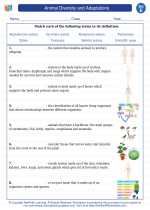Animal Diversity and Adaptations
Animals are incredibly diverse in terms of their physical characteristics, behaviors, and habitats. This diversity is a result of millions of years of evolution and adaptation to various environmental conditions. Understanding animal diversity and adaptations is essential for understanding the natural world and the interconnectedness of different species.
Types of Animal Diversity
- Vertebrates and Invertebrates: Animals can be classified into vertebrates (having a backbone) and invertebrates (lacking a backbone).
- Mammals, Birds, Reptiles, Amphibians, and Fish: Vertebrates can be further classified into these different groups based on their characteristics and adaptations.
- Arthropods, Mollusks, Annelids, and more: Invertebrates are incredibly diverse and include various groups such as arthropods (e.g., insects, spiders), mollusks (e.g., snails, squids), annelids (e.g., earthworms, leeches), and many others.
Adaptations in Animals
Adaptations are special characteristics or behaviors that help an animal survive and thrive in its environment. These adaptations can be structural, behavioral, or physiological.
Structural Adaptations
Structural adaptations are physical features of an organism that help it to survive in its environment. Examples of structural adaptations include:
- Camouflage: Some animals have colors or patterns that help them blend into their surroundings, making it easier to hide from predators or sneak up on prey.
- Beaks, Claws, and Teeth: These are specialized structures that help animals obtain food, defend themselves, or build shelters.
- Body Coverings: Some animals have special coverings such as fur, feathers, scales, or shells that provide protection from the environment or predators.
Behavioral Adaptations
Behavioral adaptations are actions or behaviors that help an animal survive in its environment. Examples of behavioral adaptations include:
- Migration: Some animals travel long distances at certain times of the year to find food, escape harsh weather, or reproduce.
- Hibernation: Certain animals enter a state of reduced activity during the winter to conserve energy and survive when food is scarce.
- Cooperative Hunting: Some animals work together in groups to hunt for food, increasing their chances of success.
Physiological Adaptations
Physiological adaptations are internal processes that help an animal survive in its environment. Examples of physiological adaptations include:
- Thermoregulation: Some animals have physiological mechanisms to regulate their body temperature, allowing them to survive in extreme hot or cold environments.
- Desert Adaptations: Certain animals have physiological adaptations such as efficient water conservation mechanisms that allow them to thrive in arid desert environments.
- High-altitude Adaptations: Animals living at high altitudes have physiological adaptations such as increased lung capacity to cope with lower oxygen levels.
Study Guide
Here are some key points to remember when studying animal diversity and adaptations:
- Understand the classification of animals into vertebrates and invertebrates.
- Learn about the different groups of vertebrates and their characteristics (mammals, birds, reptiles, amphibians, fish).
- Explore the diverse world of invertebrates, including arthropods, mollusks, annelids, and others.
- Identify and describe various structural, behavioral, and physiological adaptations in animals.
- Understand how adaptations help animals survive and thrive in different environments.
- Explore specific examples of adaptations in animals from different habitats (e.g., deserts, rainforests, oceans).
- Consider the impact of human activities on animal habitats and the need for conservation efforts to protect diverse animal species.
By understanding animal diversity and adaptations, we gain a deeper appreciation for the remarkable ways in which animals have evolved to live in diverse environments around the world.
.◂Science Worksheets and Study Guides Fifth Grade. Animal Diversity and Adaptations

 Worksheet/Answer key
Worksheet/Answer key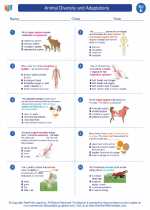
 Worksheet/Answer key
Worksheet/Answer key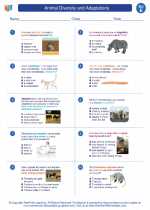
 Worksheet/Answer key
Worksheet/Answer key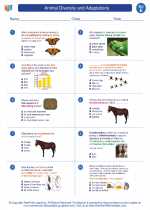
 Vocabulary/Answer key
Vocabulary/Answer key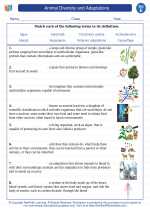
 Vocabulary/Answer key
Vocabulary/Answer key
 Vocabulary/Answer key
Vocabulary/Answer key
 Vocabulary/Answer key
Vocabulary/Answer key
 Vocabulary/Answer key
Vocabulary/Answer key